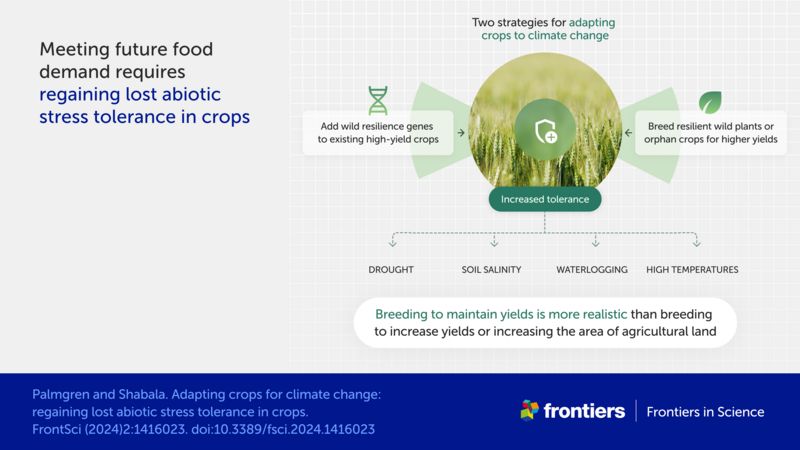Adapting crops for climate change: regaining lost abiotic stress tolerance in crops
Explainer
Front Sci, 05 December 2024
This explainer is part of an article hub, related to lead article https://doi.org/10.3389/fsci.2024.1416023
We need to adapt plants to climate crisis conditions to maintain our food supply
Although the world’s population is growing, the yield from the staple crops which anchor our diets is falling. This is due to stresses caused by the climate crisis, such as droughts and flooding. Our crops are currently optimized for high yields rather than stress tolerance, so they are ill-equipped to continue producing food in these conditions. We could produce more food by expanding agricultural land, but this would damage biodiversity and threaten the planet’s fragile ecological balance.
Writing in Frontiers in Science, Prof Michael Palmgren and Prof Sergey Shabala discuss our options for solving this problem: genetically altering high-yield plants to cope better with new conditions, or domesticating wild plants with higher stress tolerance to improve their yields.
This explainer summarizes the article’s main points.
How does the climate crisis affect crop yields?
Many factors impact a crop’s yield, or how much food each plant produces. Most staple crops are optimized to produce high yields in relatively reliable conditions and relatively cool temperatures. Abiotic stresses—stresses caused by non-biological agents that change these conditions—affect production. The climate crisis worsens these stresses.
For instance, rising temperatures lower most crops’ yield, and drought lowers them further. One estimate suggests that by 2050, 50% of yield for staple crops could be lost to drought. The reverse, flooding, also damages yield: waterlogged soil prevents the roots of most crops from taking up oxygen.
To cope with higher temperatures and drought, farmers irrigate their fields. However, because freshwater is in short supply, the water which is used for this is generally brackish. Over time, the salt from this water builds up in the soil, and the land becomes impossible to cultivate.
Why can’t current agricultural practices cope with the climate crisis?
Current intensive agriculture is based around the continuous expansion of agricultural land and the heavy use of fertilizers. Neither of these is considered sustainable, because of the impact on the wider ecosystem.
Since plants were first domesticated, farmers and scientists have prioritized those which produce more food and are easier to harvest. Over time genetic diversity has been lost, including key genes which increase abiotic stress tolerance. We also appear to have reached the ceiling of the yield that plants can supply, even without environmental challenges: since the 1960s, increases in yields have only been incremental.
What are our options for adapting crops to the climate crisis?
In order to adapt our crops to this crisis and maintain yields, we have two options:
adapt the genetic code of existing high-yield crops to maximize their tolerance of abiotic stresses
domesticate tougher wild plants to increase their yield.
The authors state that it is impossible to tell which approach will be more successful, but recommend action in both areas given the importance of the issue.

How can we improve the stress tolerance of existing crops?
We have several options to adapt existing high-yield crops through gene editing and other precision breeding techniques:
reactivating genes for stress tolerance which have become deactivated during domestication
breeding in characteristics linked to higher stress tolerance - for instance, a lower density of stomata, which stops plants losing water as quickly
inserting genes which promote stress tolerance into a plant’s DNA via genetic engineering.
These techniques are easier to accomplish when closely related plants with relevant characteristics are available; however this may not always be the case. Stress tolerance is also a complex trait reliant on the contributions of many genes, so there is unlikely to be a single, straightforward trait that can be easily selected by breeders or inserted into a plant’s genetic code.
How can we domesticate wild plants to create tougher crops?
Another possibility is de novo domestication. This would involve editing the genes of wild plants which demonstrate high levels of abiotic stress tolerance to increase their yield. Although breeding for higher yield is usually a time-consuming process, recent breakthroughs have shown that it is possible to accelerate domestication for some plants. There are relatively few genes which increase yield if manipulated, and these are conserved across species, meaning that similar manipulations could improve results across the board: the scientists refer to these as ‘low-hanging fruit’.
However, like stress tolerance, yield is a complex multi-genic trait, which means it is difficult to manipulate. Additionally, we cannot yet know if the low-hanging fruit will produce sufficient increases in yield to maintain our food supply.
What are the next steps for adapting crops to climate change?
The authors cite two challenges to overcome for both reintroducing stress tolerance genes into today’s crops and domesticating tough wild plants.
Improve our understanding of how specific stress tolerance genes work, to inform precision crop breeding efforts. The authors recommend increased use of cell-based phenotyping—which can describe and characterize mechanisms down to the cellular level—rather than traditional physiological profiling of traits based on whole plants, which can lose critical information.
Increase the public acceptance of these new crops. Currently, public understanding of plant gene technologies is limited. Better communication is needed to explain the impact of climate change on agriculture and how new, adapted crops can help us maintain food security.